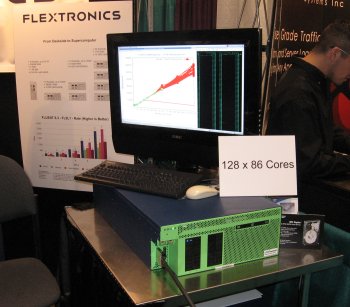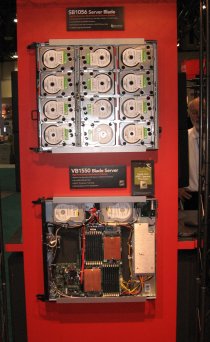Commodity CPUs are Getting FAST
While HPC is already about performance, the other thing that I think is significant at SC07, is that Intel announced their Penryn family of chips. While normally this isn't such a big deal, the benchmarks that Doug Eadline, our fearless head monkey, has run indicate that it an significant improvement in performance over past quad-core designs. Doug's benchmarks were sponsored by Appro. Look at Appro's website for a copy of the paper. It's truly amazing.
I see these benchmarks as being a new trend in commodity processors. The CPU manufacturers are introducing changes into their chips that are really the HPC community. Look at the fact that SGI and Cray are using commodity processors in some of the products. Commodity CPUs are getting FAST.
The next generation of Intel processors, currently with the code name Nehalem, look to be faster still. They will feature an on-board memory controller, a new on-the-board interconnect called QuickPath (somewhat like Hypertransport), and up to 8 cores per socket. The rumor is that Nehalem will be an amazing performing CPU. I've even heard rumors that it will rival IBM's Power6 CPU. All of this at a commodity price - wow!. We'll have to wait for real benchmarks, but the promise looks great (To quote a famous line from a movie, "you can wish in one hand and cra* in the other - which one will you get first?" - can anyone tell me what movie that is from?).
Variations
I saw a few other things around the floor that impressed me but didn't really fall into the "themes" I've previously mentioned. I'm going to mention two in this article that impressed me.
Flextronics and the Personal Supercomputer
The first one is a work group personal cluster that was developed by, of all vendors, Flextronics. Flextronics, is one of the largest manufacturers in the computer world. They make motherboards, cases, and systems for almost every vendor you can think of at SC07. Most of them don't admit it but they do. Flextronics also can design components for vendors. The have honed the ability to manufacture, ship, and support components to a fine art. There aren't many, if any, companies that can do it better. So, it's very interesting that they are now developing systems (why not? They do all of the other pieces extremely well).
They have designed a chassis that has, I think, four two-socket boards inside. The picture below in Figure Four shows the chassis.

You can see the Infiniband cable coming out of the front of the case. It connects to a chassis that is below the one in the picture.
If you put quad-core processors in each socket, then you have 32 cores per chassis. Flextronics was showing 4 chassis for a total of 128 cores. They were also running ScaleMP on the system. ScaleMP has a product referred to as vSMP that allows you to connect several systems together to make them appear as a large SMP machine. You don't have to use MPI to code for distributed nodes. Using vSMP allows the disparate nodes to appear as one large machine. The plot on the screen above the chassis shows the memory bandwidth as a function of the number of cores. To me the plot looks fairly linear. I'll have to look at ScaleMP a little closer.
I'm working on an article about Personal Supercomputers (PSC) that give a little history of PSC's and present current PSC's. Look for it at a ClusterMonkey near you.
Verari and Storage Blades
Verari is an HPC vendor that has expanded beyond just HPC, but still always pays attention to it's HPC roots. I always enjoy going to their booth and seeing what new things they have cooked up. When I stopped by and this year it was no exception. Verari is one of the pioneers in the commodity blade area. They also utilize vertical cooling in their HPC systems since, guess what, hot air rises, so just take advantage of natural convection to push the hot air upward and out of the rack. Over the years their blades have evolved and at SC07 I got to see one of their new storage blades as show below.

The top blade in the image is the storage blade. It's mounted just like it would be in a rack.
The blade in the image shows a total of 12 SATA drives that are 1 TB in size for a total of 12 TB in a blade. From what I understand you can connect this storage blade via a connector to a node with a RAID card. I also think that the drives in this blade are hot-swappable. Very nice design.
One word of caution though. This is about the limit that you want connected to a single RAID card (12TB). While I have a file system article coming to ClusterMonkey that explains this in more detail, the fundamental reason is that if you lose a drive, in the case of RAID-5, or 2 drives, in the case of RAID-6, you are almost guaranteed to hit a read error while reconstructing the data. This will cause the reconstruction to fail and you will have to restore all of the data from a backup. Restoring 12TB of data from backup will take a long time.
SC07 - I've Recovered (I think)
It's been at least a week since SC07 and I think I've recovered. My sleep pattern was a mess but I think I've straightened that out. I still hear the faint sound of slot machines in my nightmares. I'm looking forward to SC08 and I'm going to definitely make more time to walk the floor and visit more booths, more friends, and my pillows much more often. I hope to see you there!
Jeff Layton is a cluster enthusiast who travels the world writing about clusters while trying to stamp out cluster/HPC stupidity where ever he can find it (it's definitely out there). He can be reached This email address is being protected from spambots. You need JavaScript enabled to view it..


